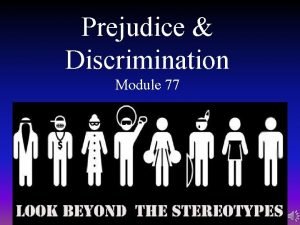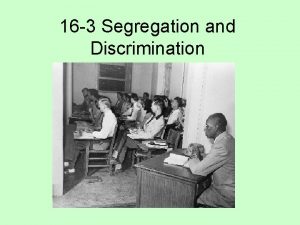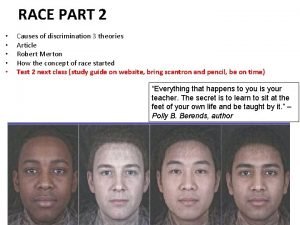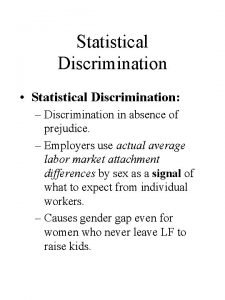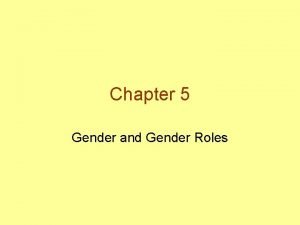LO to understand Gender And Discrimination in AIC


























- Slides: 26

LO: to understand Gender And Discrimination in AIC. An Inspector Calls


At the time of the setting of the play… • Women were used as possessions by men • Women didn’t have the same rights as men • Even upper class women had few choices. For most, the best they could hope for was to impress a rich man and marry well - which could explain why Sheila spent so long in Milwards.

At the time of the setting of the play… • Upper class women could only hope for a bright future if they found a rich man and Sheila was successful in doing so therefore there was so much celebration in the Birling Household in the beginning of the play.

At the time of the setting of the play… • For working class women, a job was crucial. There was no social security at that time, so without a job they had no money. There were very few options open to women in that situation: many saw no alternative but to turn to prostitution. • Eva Smith represented all the working class women at the time and that is how the viewers get to understand their situation at the time.

At the time of the setting of the play… • Times were starting to change (the play is set at a time of political and social unrest. )

How is theme presented? • The way that the men try to protect Sheila and Mrs Birling throughout the play. -‘Sheila take your mother along to the drawing-room – …go on Sybil. ’ • Mr Birling is dismissive of the several hundred women in his factory: - "We were paying the usual rates and if they didn't like those rates, they could go and work somewhere else. ”

How is theme presented? • Mr. Birling ‘Nothing to do with you, Sheila. Run along. ’ – views Sheila as unable to understand situations and so tries to exclude her • Gerald saw Eva as "young and fresh and charming" - in other words, someone vulnerable he could amuse himself by helping.

How is theme presented? • Mrs Birling couldn't believe that "a girl of that sort would ever refuse money. " • Her charitable committee was a sham: a small amount of money was given to a small amount of women, hardly ever making the lives of lower-class women better.

How is theme presented? • Eva smith, being a lower class woman, lived in a society where she had no influence or power. • ‘She’d had a lot to say - far too much - she had to go’. • Her identity as a woman is deeply bound with the identity as a member of the working class.

How theme is reflected through each female character… • Mrs. Birling - middle class woman of considerable influence - involved in good works, considered a suitable occupation for a lady in society. • Women of higher classes did not work, but did only charitable work. This was seen as acceptable as it was a caring role that fitted with the idealised Victorian view, still held then, of women as mothers. She accepts her role as a married woman of a rich guy whose work is very important.

How theme is reflected through each female character… • Sheila - follows this path by not working, the only occupation mentioned which she does is shopping. Mr. Birling (pg 9) ‘Yes, but you’ve got to remember, my boy, that clothes mean something quite different to a woman. ’ However, her character opposes the nature of theme throughout: Sheila has greater independence in mind and spirit and she does not comply with the ordinary attitudes. For example, she is not ready to accept the fact Gerald’s work will come between their relationship: ‘I don’t believe I will’, and objects to Birling’s commands: ‘protesting’.

How theme is reflected through each female character… Daisy/Eva - a working class girl, possibly an orphan, who has to work for a living and is seen to be completely at the mercy of men.

How the Inspector handles it… • He does not dismiss Eva just because she had to go to prostitution- he realizes that she had no choice. • He treats her death with a strong concerned attitude; does not dissolve the intensity of the crime just because the victim was female.

How the Inspector handles it… • Talks firmly and severely to both genders- no difference between them. • Inspector (pg 27) ‘And you think young women ought to be protected against unpleasant and disturbing things? ’ : He is trying to back up women in society and questions the altered attitude towards them.

How theme contributes to Eva’s death At the point when Eva had nothing to live for: ‘…no home to go back to…’, and the fact that she is pregnant, without any financial support, because of gender and womanhood, it is that pushes her over the edge. As a result of Eva's position as a woman - in the days before women were valued by society and had not yet been awarded the right to vote - she was in an even worse position than a lower class man.

Why a woman? Significant that the victim is a woman- the play may not have been successful if the victim was a man- grabs sympathy from the audience and so it is essential that Eva is shown as vulnerable as possible (if the victim was a man they would not have been taken advantage of and exposed to such cruelty like Eva was by Gerald and Eric sexually)

What do each of the three women represent in the play?

Eva Smith Doesn’t seek revenge – who does seek it for her? Are Eva Smith and Daisy Renton the same woman? Central to the play’s message.

Eva Smith 1912: the Suffragettes switched to more militant tactics, including chaining themselves to buildings, setting fire to postboxes and smashing windows. Eventually, over a thousand women were imprisoned. Once there, many went on hunger strike to protest against their treatment. Eva Smith is meant, in part, to represent the struggles of the Suffragette movement. Her encounter with Mr Birling mirrors the many failed attempts of the Suffragettes to convince MPs to vote for universal suffrage prior to the First World War.

WW 1 Effects WW 1 greatly accelerated the Suffragette cause: millions of women went to work in the various munitions factories. On the 4 th of February, 1918, the Representation of the People Act was passed, granting voting rights to property-owning women over the age of 30.

Sheila Language makes her seem childish at first.

• Sheila • In act one, when she learns of Eva's dismissal from her father's factory, Sheila openly sides against Mr Birling and with the Inspector – quote? • "But these girls aren't cheap labour - they're people. " • She is not prepared to submit to what were traditionally her male superiors. • Sheila half-teasingly, half-seriously rebuke's her fiancée Gerald for being so distant the previous summer. • Her mother tells her that she will have to get used to men spending lots of time on their work. • Sheila is not prepared to suffer the indignity of being second to men and their desires. • When does she give back her engagement ring? Effect? • By doing this, Sheila gives up all the money, comfort and prestige that would come from accepting Gerald's actions and marrying into his family. • Instead, she stands up for herself and for the ideals of socialism.

• When her father tries to convince her to reconsider breaking off the engagement, Sheila angrily dismisses him: (Quote? ) • Birling: Now, Sheila, I'm not defending him. But you must understand that a lot of young men • Sheila: Don't interfere, please, Father. Gerald knows what I mean, and you apparently don't. • Sheila is quite right: just as Mr Birling does not understand socialism or politics or global affairs, so he does not understand women - or at least, the new generation of women that is waking up around him. • Alone with Gerald and Eric, Mr Birling makes an observation that shows his shallow understanding of women: (quote? ) • ‘Yes, but you've got to remember, my boy, that clothes mean something quite different to a woman. Not just something to wear - and not only something to make 'em look prettier - but - well, a sort of sign or token of their self-respect. ’ • Sheila does like clothes, but she shows her self-respect by standing up for what she believes in. • Mr Birling's first line is a remark about port to his servant, Edna, a woman who appears very briefly and says nothing beyond what is necessary. She could be counted among the "millions of Eva Smiths" without a voice.

Mrs Birling Doesn’t change.

What shows Mrs Birling’s views? When Sheila rebuke's her fiancée, Gerald, for being so distant the previous summer, her mother tells her that she will have to get used to men spending lots of time on their work. Sybil, stiff and unsympathetic, represents the old generation of women, content to come second to men.
 Gender in aic
Gender in aic Poem about gender equality
Poem about gender equality Strategic gender needs and practical gender needs
Strategic gender needs and practical gender needs To understand recursion you must understand recursion
To understand recursion you must understand recursion Aic in r
Aic in r What is a good aic value
What is a good aic value Aic equipment
Aic equipment Left aic pattern exercises
Left aic pattern exercises Aic requirements
Aic requirements Www.unsplash.com
Www.unsplash.com Sostituto di adobe flash player
Sostituto di adobe flash player Journal of mountain science
Journal of mountain science Aic rail
Aic rail Aic machine learning
Aic machine learning Aic napoli
Aic napoli Usually negative, _____ is an attitude or prejudgment.
Usually negative, _____ is an attitude or prejudgment. Antilocution definition
Antilocution definition Chapter 8 section 3 segregation and discrimination
Chapter 8 section 3 segregation and discrimination Chapter 8 section 3 segregation and discrimination
Chapter 8 section 3 segregation and discrimination Allport's scale diagram
Allport's scale diagram In what region did racial etiquette exist
In what region did racial etiquette exist Government chapter 21 diversity and discrimination
Government chapter 21 diversity and discrimination Diversity and discrimination
Diversity and discrimination Merton's typology of prejudice and discrimination
Merton's typology of prejudice and discrimination Is stuttering a disability under the ada
Is stuttering a disability under the ada Brightness adaptation and discrimination
Brightness adaptation and discrimination Langkah teks eksplanasi
Langkah teks eksplanasi















